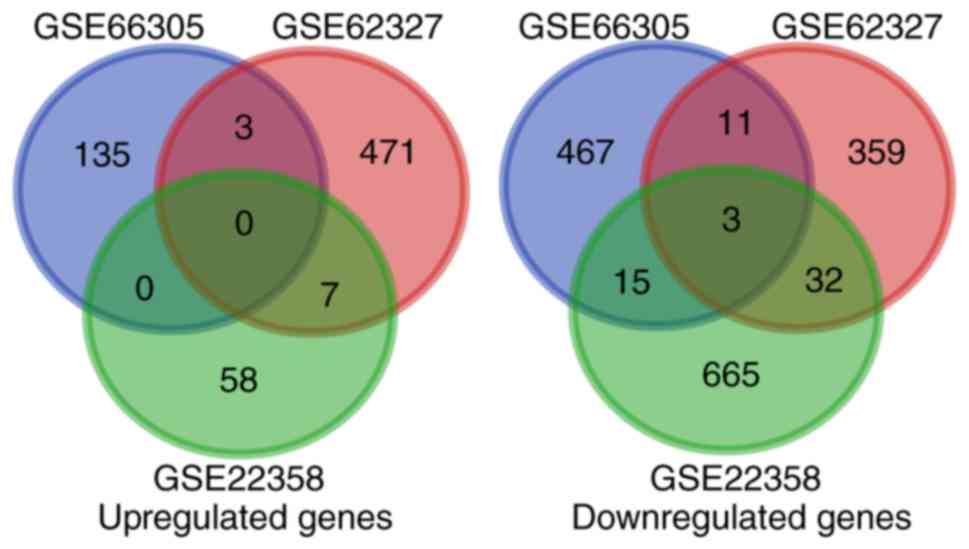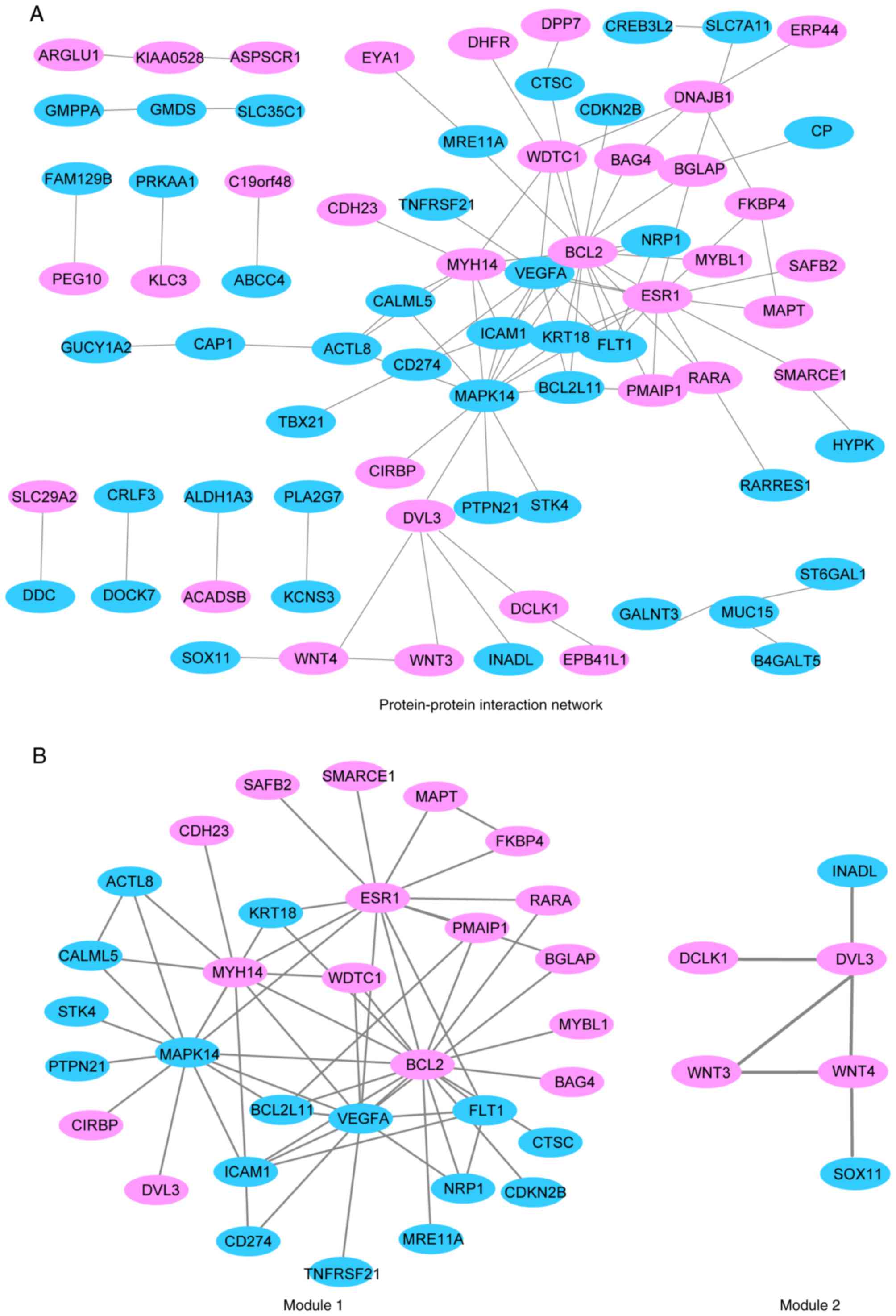|
1
|
Siegel RL, Miller KD and Jemal AL: Cancer
statistics, 2017. CA Cancer J Clin. 67:7–30. 2017. View Article : Google Scholar : PubMed/NCBI
|
|
2
|
Guarneri V, Broglio K, Kau SW,
Cristofanilli M, Buzdar AU, Valero V, Buchholz T, Meric F,
Middleton L, Hortobagyi GN and Gonzalez-Angulo AM: Prognostic value
of pathologic complete response after primary chemotherapy in
relation to hormone receptor status and other factors. J Clin
Oncol. 24:1037–1044. 2006. View Article : Google Scholar : PubMed/NCBI
|
|
3
|
Romond EH, Perez EA, Bryant J, Suman VJ,
Geyer CE Jr, Davidson NE, Tan-Chiu E, Martino S, Paik S, Kaufman
PA, et al: Trastuzumab plus adjuvant chemotherapy for operable
HER2-positive breast cancer. N Engl J Med. 353:1673–1684. 2005.
View Article : Google Scholar : PubMed/NCBI
|
|
4
|
Slamon D, Eiermann W, Robert N, Pienkowski
T, Martin M, Press M, Mackey J, Glaspy J, Chan A, Pawlicki M, et
al: Adjuvant trastuzumab in HER2-positive breast cancer. N Engl J
Med. 365:1273–1283. 2011. View Article : Google Scholar : PubMed/NCBI
|
|
5
|
Gianni L, Eiermann W, Semiglazov V,
Manikhas A, Lluch A, Tjulandin S, Zambetti M, Vazquez F, Byakhow M,
Lichinitser M, et al: Neoadjuvant chemotherapy with trastuzumab
followed by adjuvant trastuzumab versus neoadjuvant chemotherapy
alone, in patients with HER2-positive locally advanced breast
cancer the NOAH trial): A randomised controlled superiority trial
with a parallel HER2-negative cohort. Lancet. 375:377–384. 2010.
View Article : Google Scholar : PubMed/NCBI
|
|
6
|
Untch M, Rezai M, Loibl S, Fasching PA,
Huober J, Tesch H, Bauerfeind I, Hilfrich J, Eidtmann H, Gerber B,
et al: Neoadjuvant treatment with trastuzumab in HER2-positive
breast cancer: Results from the GeparQuattro study. J Clin Oncol.
28:2024–2031. 2010. View Article : Google Scholar : PubMed/NCBI
|
|
7
|
Nahta R and Esteva FJ: HER2 therapy:
Molecular mechanisms of trastuzumab resistance. Breast Cancer Res.
8:2152006. View
Article : Google Scholar : PubMed/NCBI
|
|
8
|
Berns K, Horlings HM, Hennessy BT,
Madiredjo M, Hijmans EM, Beelen K, Linn SC, Gonzalez-Angulo AM,
Stemke-Hale K, Hauptmann M, et al: A functional genetic approach
identifies the PI3K pathway as a major determinant of trastuzumab
resistance in breast cancer. Cancer Cell. 12:395–402. 2007.
View Article : Google Scholar : PubMed/NCBI
|
|
9
|
Barbareschi M, Cuorvo LV, Girlando S,
Bragantini E, Eccher C, Leonardi E, Ferro A, Caldara A, Triolo R,
Cantaloni C, et al: PI3KCA mutations and/or PTEN loss in
Her2-positive breast carcinomas treated with trastuzumab are not
related to resistance to anti-Her2 therapy. Virchows Arch.
461:129–139. 2012. View Article : Google Scholar : PubMed/NCBI
|
|
10
|
de Oliveira Taveira M, Nabavi S, Wang Y,
Tonellato P, Esteva FJ, Cantley LC and Wulf GM: Genomic
characteristics of trastuzumab-resistant Her2-positive metastatic
breast cancer. J Cancer Res Clin Oncol. 143:1255–1262. 2017.
View Article : Google Scholar : PubMed/NCBI
|
|
11
|
Bianchini G, Kiermaier A, Bianchi GV, Im
YH, Pienkowski T, Liu MC, Tseng LM, Dowsett M, Zabaglo L, Kirk S,
et al: Biomarker analysis of the NeoSphere study: Pertuzumab,
trastuzumab, and docetaxel versus trastuzumab plus docetaxel,
pertuzumab plus trastuzumab, or pertuzumab plus docetaxel for the
neoadjuvant treatment of HER2-positive breast cancer. Breast Cancer
Res. 19:162017. View Article : Google Scholar : PubMed/NCBI
|
|
12
|
Gluck S, Ross JS, Royce M, McKenna EF Jr,
Perou CM, Avisar E and Wu L: TP53 genomics predict higher clinical
and pathologic tumor response in operable early-stage breast cancer
treated with docetaxel-capecitabine ± trastuzumab. Breast Cancer
Res Treat. 132:781–791. 2012. View Article : Google Scholar : PubMed/NCBI
|
|
13
|
Guarneri V, Dieci MV, Frassoldati A,
Maiorana A, Ficarra G, Bettelli S, Tagliafico E, Bicciato S,
Generali DG, Cagossi K, et al: Prospective biomarker analysis of
the randomized CHER-LOB study evaluating the dual anti-HER2
treatment with trastuzumab and lapatinib plus chemotherapy as
neoadjuvant therapy for HER2-positive breast cancer. Oncologist.
20:1001–1010. 2015. View Article : Google Scholar : PubMed/NCBI
|
|
14
|
Triulzi T, De Cecco L, Sandri M, Prat A,
Giussani M, Paolini B, Carcangiu ML, Canevari S, Bottini A, Balsari
A, et al: Whole-transcriptome analysis links trastuzumab
sensitivity of breast tumors to both HER2 dependence and immune
cell infiltration. Oncotarget. 6:28173–28182. 2015. View Article : Google Scholar : PubMed/NCBI
|
|
15
|
Bader GD and Hogue CW: An automated method
for finding molecular complexes in large protein interaction
networks. BMC Bioinformatics. 4:22003. View Article : Google Scholar : PubMed/NCBI
|
|
16
|
Toomey S, Eustace AJ, Fay J, Sheehan KM,
Carr A, Milewska M, Madden SF, Teiserskiene A, Kay EW, O'Donovan N,
et al: Impact of somatic PI3K pathway and ERBB family mutations on
pathological complete response (pCR) in HER2-positive breast cancer
patients who received neoadjuvant HER2-targeted therapies. Breast
Cancer Res. 19:872017. View Article : Google Scholar : PubMed/NCBI
|
|
17
|
Yakes FM, Chinratanalab W, Ritter CA, King
W, Seelig S and Arteaga CL: Herceptin-induced inhibition of
phosphatidylinositol-3 kinase and Akt is required for
antibody-mediated effects on p27, cyclin D1, and antitumor action.
Cancer Res. 62:4132–4141. 2002.PubMed/NCBI
|
|
18
|
Nagata Y, Lan KH, Zhou X, Tan M, Esteva
FJ, Sahin AA, Klos KS, Li P, Monia BP, Nguyen NT, et al: PTEN
activation contributes to tumor inhibition by trastuzumab, and loss
of PTEN predicts trastuzumab resistance in patients. Cancer Cell.
6:117–127. 2004. View Article : Google Scholar : PubMed/NCBI
|
|
19
|
Molina MA, Codony-Servat J, Albanell J,
Rojo F, Arribas J and Baselga J: Trastuzumab (herceptin), a
humanized anti-Her2 receptor monoclonal antibody, inhibits basal
and activated Her2 ectodomain cleavage in breast cancer cells.
Cancer Res. 61:4744–4749. 2001.PubMed/NCBI
|
|
20
|
Clynes RA, Towers TL, Presta LG and
Ravetch JV: Inhibitory Fc receptors modulate in vivo cytotoxicity
against tumor targets. Nat Med. 6:443–446. 2000. View Article : Google Scholar : PubMed/NCBI
|
|
21
|
Hanahan D and Weinberg RA: Hallmarks of
cancer: The next generation. Cell. 144:646–674. 2011. View Article : Google Scholar : PubMed/NCBI
|
|
22
|
Dey N, De P and Leyland-Jones B:
PI3K-AKT-mTOR inhibitors in breast cancers: From tumor cell
signaling to clinical trials. Pharmacol Ther. 175:91–106. 2017.
View Article : Google Scholar : PubMed/NCBI
|
|
23
|
Okutur K, Bassulu N, Dalar L, Aydin K,
Bozkurt M, Pilanci KN, Dogusoy GB, Tecimer C, Mandel NM and Demir
G: Predictive and prognostic significance of p27, Akt, PTEN and
PI3K expression in HER2-positive metastatic breast cancer. Asian
Pac J Cancer Prev. 16:2645–2651. 2015. View Article : Google Scholar : PubMed/NCBI
|
|
24
|
Lan KH, Lu CH and Yu D: Mechanisms of
trastuzumab resistance and their clinical implications. Ann N Y
Acad Sci. 1059:70–75. 2005. View Article : Google Scholar : PubMed/NCBI
|
|
25
|
Timmermans-Sprang EP, Gracanin A and Mol
JA: High basal Wnt signaling is further induced by PI3K/mTor
inhibition but sensitive to cSRC inhibition in mammary carcinoma
cell lines with HER2/3 overexpression. BMC Cancer. 15:5452015.
View Article : Google Scholar : PubMed/NCBI
|
|
26
|
Klos KS, Zhou X, Lee S, Zhang L, Yang W,
Nagata Y and Yu D: Combined trastuzumab and paclitaxel treatment
better inhibits ErbB-2-mediated angiogenesis in breast carcinoma
through a more effective inhibition of Akt than either treatment
alone. Cancer. 98:1377–1385. 2003. View Article : Google Scholar : PubMed/NCBI
|
|
27
|
Palomero J, Vegliante MC, Rodriguez ML,
Eguileor A, Castellano G, Planas-Rigol E, Jares P, Ribera-Cortada
I, Cid MC, Campo E and Amador V: SOX11 promotes tumor angiogenesis
through transcriptional regulation of PDGFA in mantle cell
lymphoma. Blood. 124:2235–2247. 2014. View Article : Google Scholar : PubMed/NCBI
|
|
28
|
Kuo PY, Leshchenko VV, Fazzari MJ, Perumal
D, Gellen T, He T, Iqbal J, Baumgartner-Wennerholm S, Nygren L,
Zhang F, et al: High-resolution chromatin immunoprecipitation ChIP)
sequencing reveals novel binding targets and prognostic role for
SOX11 in mantle cell lymphoma. Oncogene. 34:1231–1240. 2015.
View Article : Google Scholar : PubMed/NCBI
|
|
29
|
Huang B, Warner M and Gustafsson JÅ:
Estrogen receptors in breast carcinogenesis and endocrine therapy.
Mol Cell Endocrinol. 418:240–244. 2015. View Article : Google Scholar : PubMed/NCBI
|
|
30
|
Menyhart O, Santarpia L and Győrffy B: A
comprehensive outline of trastuzumab resistance biomarkers in HER2
overexpressing breast cancer. Curr Cancer Drug Targets. 15:665–683.
2015. View Article : Google Scholar : PubMed/NCBI
|
|
31
|
Gianni L, Pienkowski T, Im YH, Roman L,
Tseng LM, Liu MC, Lluch A, Staroslawska E, de la Haba-Rodriguez J,
Im SA, et al: Efficacy and safety of neoadjuvant pertuzumab and
trastuzumab in women with locally advanced, inflammatory, or early
HER2-positive breast cancer (NeoSphere): A randomised multicentre,
open-label, phase 2 trial. Lancet Oncol. 13:25–32. 2012. View Article : Google Scholar : PubMed/NCBI
|
|
32
|
Rimawi MF, Mayer IA, Forero A, Nanda R,
Goetz MP, Rodriguez AA, Pavlick AC, Wang T, Hilsenbeck SG,
Gutierrez C, et al: Multicenter phase II study of neoadjuvant
lapatinib and trastuzumab with hormonal therapy and without
chemotherapy in patients with human epidermal growth factor
receptor 2-overexpressing breast cancer: TBCRC 006. J Clin Oncol.
31:1726–1731. 2013. View Article : Google Scholar : PubMed/NCBI
|
|
33
|
Montemurro F, Rossi V, Rocca Cossu M,
Martinello R, Verri E, Redana S, Adamoli L, Valabrega G, Sapino A,
Aglietta M, et al: Hormone-receptor expression and activity of
trastuzumab with chemotherapy in HER2-positive advanced breast
cancer patients. Cancer. 118:17–26. 2012. View Article : Google Scholar : PubMed/NCBI
|
|
34
|
Park SH, Kim H and Song BJ: Down
regulation of bcl2 expression in invasive ductal carcinomas is both
estrogen- and progesterone-receptor dependent and associated with
poor prognostic factors. Pathol Oncol Res. 8:26–30. 2002.
View Article : Google Scholar : PubMed/NCBI
|
|
35
|
Aizawa K, Ueki K, Suzuki S, Yabusaki H,
Kanda T, Nishimaki T, Suzuki T and Hatakeyama K: Apoptosis and
Bbcl-2 expression in gastric carcinomas: Correlation
withclinicopathological variables, p53 expression, cell
proliferation and prognosis. Int J Oncol. 14:85–91. 1999.PubMed/NCBI
|
|
36
|
Eom YH, Kim HS, Lee A, Song BJ and Chae
BJ: BCL2 as a Subtype-specific prognostic marker for breast cancer.
J Breast Cancer. 19:252–260. 2016. View Article : Google Scholar : PubMed/NCBI
|
|
37
|
Dawson SJ, Makretsov N, Blows FM, Driver
KE, Provenzano E, Le Quesne J, Baglietto L, Severi G, Giles GG,
McLean CA, et al: BCL2 in breast cancer: A favourable prognostic
marker across molecular subtypes and independent of adjuvant
therapy received. Br J Cancer. 103:668–675. 2010. View Article : Google Scholar : PubMed/NCBI
|
|
38
|
Hwang KT, Han W, Kim J, Moon HG, Oh S,
Song YS, Kim YA, Chang MS and Noh DY: Prognostic Influence of BCL2
on molecular subtypes of breast cancer. J Breast Cancer. 20:54–64.
2017. View Article : Google Scholar : PubMed/NCBI
|
|
39
|
Crawford A and Nahta R: Targeting Bcl-2 in
Herceptin-resistant breast cancer cell lines. Curr Pharmacogenomics
Person Med. 9:184–190. 2011. View Article : Google Scholar : PubMed/NCBI
|
|
40
|
Giuliano M, Hu H, Wang YC, Fu X, Nardone
A, Herrera S, Mao S, Contreras A, Gutierrez C, Wang T, et al:
Upregulation of ER signaling as an adaptive mechanism of cell
survival in HER2-positive breast tumors treated with Anti-HER2
therapy. Clin Cancer Res. 21:3995–4003. 2015. View Article : Google Scholar : PubMed/NCBI
|
|
41
|
Yang Q, Moran MS and Haffty BG: Bcl-2
expression predicts local relapse for early-stage breast cancer
receiving conserving surgery and radiotherapy. Breast Cancer Res
Treat. 115:343–348. 2009. View Article : Google Scholar : PubMed/NCBI
|
















